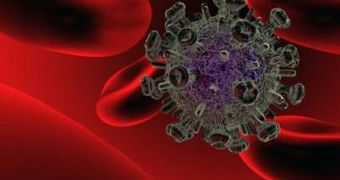The conclusions of a new series of phase I clinical trials show that a new vaccine developed against the human immunodeficiency virus (HIV) manages to elicit immune responses in 90 percent of patients. About 85 percent of test subjects display the same response 12 months later.
According to scientists who conducted the tests, the modified viral agent that constitutes the backbone of the new therapy is both safe and efficient in the vast majority of the test population. The work has been published in issues of both Vaccine and Journal of Virology magazines.
The Spanish Superior Scientific Research Council (CSIC), the Gregorio Marañón Hospital, in Madrid, and Clínic Hospital, in Barcelona, were the main actors involved in setting up the novel therapeutic approach, as well as the new clinical trials.
MVA-B – the vaccine used on all patients – is patented by CSIC. It relies on boosting the human immune system's ability to mount an effective response against all types of invaders, if given enough time. Virus particles and infected cells are constant targets, but our defenses need time to attack them.
CSIC National Biotech Center (NBC) head researcher Mariano Esteban explains that the “MVA-B vaccine has proven to be as powerful as any other vaccine currently being studied, or even more,” EurekAlert reports.
MVA-B was first demonstrated to be tremendously efficient against HIV in tests conducted on infect lab mice. Subsequent researches analyzed its effectiveness against Simian's immunodeficiency virus (SIV), a form of retrovirus similar to HIV that attacks monkeys.
The new vaccine is based on the Modified Ankara Vaccinia viral agent. Researchers with the joint team augment the microorganism with four HIV genes – Gag, Pol, Nef and Env – so that when the immune system reacts against this lesser opponent, it also learns to fight the real target.
MVA-B has a “B” in its name because it is designed specifically to fight HIV subtype B, which is the most commonly spread throughout Europe. According to the team, the safety of the clinical trials is guaranteed by the fact that the HIV genes the lesser virus carries cannot self-replicate.
The phase I clinical trials were double-blind experiments, in which 24 of 30 participants were treated with MVA-B, whereas the other 6 were given a placebo. Vaccine shots were given the patients at weeks 0, 4 and 16, and the study ended on week 48.
“Our body is full of lymphocytes, each of them programmed to fight against a different pathogen. Training is needed when it involves a pathogen, like the HIV one, which cannot be naturally defeated,” Esteban says, adding that these two types of immune cells are the target of MVA-B.
At week 48, all patients in the control group displayed lymphocytes T CD4+ and CD8+ production levels of 0 percent, whereas all subjects in the test group had production rates of 38,5 and 69,2 percent, respectively.
“If this genetic cocktail passes Phase II and Phase III future clinic trials, and makes it into production, in the future HIV could be compared to herpes virus nowadays,” Esteban concludes.

 14 DAY TRIAL //
14 DAY TRIAL //